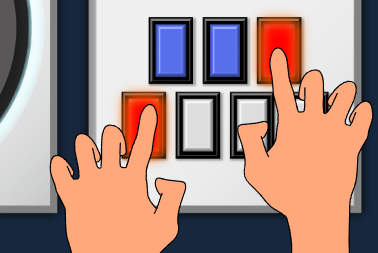Playstyles for beatmania IIDX SP
Table of contents
Introduction
This page will cover some of the most common playstyles in IIDX. There are plenty of styles in active use by high-level players that are not covered here.
If you are a beginner, please read Tips for Beginners page first for suggestions.
Most play styles are totally viable, and you will not have any major trouble reaching Kaiden. Some styles are harder to learn, while others might give you trouble on certain patterns.
Insane BMS is a different story and that is not the focus of this website. Styles that are not as viable are specifically called out in the last section of this page.
This page will use the following numbering scheme. Button #1 is the button closest to the turntable on either side.

Your scratch hand is the hand closer to the turntable, which would be left hand for 1P and right hand for 2P. Button hand is the other hand.
Click here to flip 1P / 2P view.
3/4 split - scratch hand (S+123)
1048 style and variants
This is currently the most used playstyle; it was popularized by former top ranker 1048 (pronounced Toshiya, not ten-forty-eight).
Thumb on 1, middle finger on 2, and index on 3. Move your elbow slightly closer to the turntable.
The advantage is that this gives your pinky close to the turntable, and it is easy to switch to a 2:5 formation as needed by straightening out your arm slightly. The downside is that it is difficult to learn initially due to the unusual ordering of fingers.
There are a few variants of this style.
Transitional 1048
In this variation of 1048, you normally have three fingers on buttons 1-3. When you need to hit the turntable, you temporarily switch to another playstyle (usually 2:5 formation – thumb on 1, index on 2) – and then switch back. Use the thumb on 1 as a pivot.

Occasionally you’ll need to hit button 3 with your other hand thumb while remaining in 1048 position; don’t be shy about doing this.
Example: LICHT playing 1048 and transitioning into 3/5
Example: KKM playing transitional 1048, occasionally switching to wrist or 3/5
Example: NORI with transitional 1048
Wrist scratch 1048
In this variation of 1048, you use your wrist movement for the turntable.
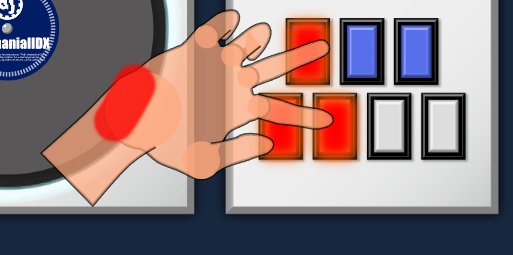
While it’s called “wristing”, it doesn’t have to be your wrist that comes in contact with the turntable. Depending on your preference (mostly hand size dependent), it could be the bottom part of your palm, the wrist, or a part of your arm.
It was not a major playstyle in the past. It was initially popularized by insane BMS players who played with this style on the original JKOC controller, where the turntable distance is shorter. IIDX players started to adopt it when more high density charts were being normalized.
Most players rotate their entire body slightly away from the turntable (to the right for 1p), so that you can place your scratch arm almost perpendicular to the cabinet. You might also find it more comfortable if you shift closer to the turntable side.
Wristing has been a controversial topic among traditional players in the past, but as U*TAKA and RAG have shown, it is a competitive playstyle that is becoming less divisive.
Fixed 1048 (aka “god pinky”)
In this variation of 1048, you keep your three fingers static on buttons 1-3, but stretch out your pinky to move the turntable (without really moving away from button 3). This is only possible if you have large hands and/or long fingers – hence the name god pinky!
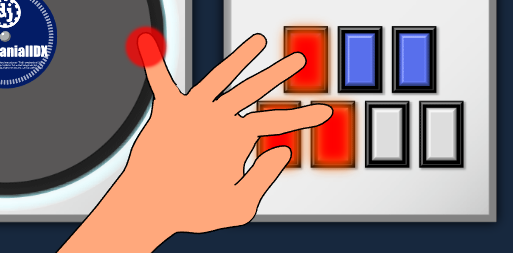
Worth noting that this style is not all that common, compared to transitional 1048 or wrist scratch; most people find this contortion of the pinky impossible or uncomfortable.
Example: EBEBEBY with god pinky. Note that his right hand style (middle-index-pinky-thumb) is extremely unusual and not recommended for beginners.
Thumb-index-thumb (aka 3/5 or thumb slide)
Index is fixed on 2, but the thumb moves between 1 and 3.

One major advantage is that it’s easy to scratch without deviating away from the home position.
However, since two fingers are responsible for three buttons, there are difficulties when dealing with patterns with heavy 1 and 3 notes.
To overcome this:
- you can bring the other hand thumb over to hit button 3, sharing the responsibility of button 3 with your left thumb. This is called 3/5.
- just use this in conjunction with other playstyles like TAKA.s or 1048.
Example: LICHT playing 1048 and transitioning into 3/5
Becha press (aka TAKA.S)
This is popularized by top ranker TAKA.S. While it is not as popular as 1048, it is still one of the major playstyles that remain among high-level players.
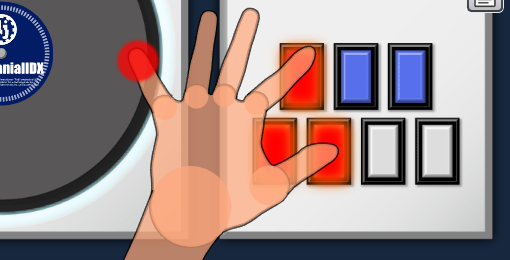
The difference between the style above and this – is that the thumb can hit 1 and 3 without much movement. This is accomplished by using different parts of the thumb, as opposed to just using the tip of your thumb. You either use the bottom part of your thumb or part of the palm that connects to your thumb to press button 1.
Like 3/5, this style allows you to scratch without moving away from the buttons, but can be difficult when the pattern relies heavily on buttons 1 and 3.
Example - TAKA.S playing reunion and Mendes black
Example - NEON (2P) playing Troopers CS Kaiden. Another example is ICARUS SPL - especially 1:40 to 2:02
Example - nsi playing Insane Kaiden
Thumb-index-thumb vs. becha press
One commonly asked question is, what’s the difference between the two styles?
Technically, thumb-index-thumb is when you use the tip of your thumb ot press button #1, becha press is using the lower part of your thumb. Therefore, thumb-index-thumb requires you to be more “dynamic”, while becha press is more of a static configuration.
Sure, some players exclusively use one style or the other, but most players will use both techniques fluently, since they each have their weaknesses to specific patterns.
To use the videos above as examples: you can see that TAKA.S frequently moves the thumb between 1 and 3. nsi is the opposite, their thumb is almost fixed on top of 1 and 3 simultaneously. NEON is somewhere in the middle, using both as required by the chart.
Middle-index-thumb (aka “Dolce style”)
In the past, this was one of the popular playstyles. While this is known as Dolce style, it is a bit of a misnomer, as he uses a variety of playstyles.
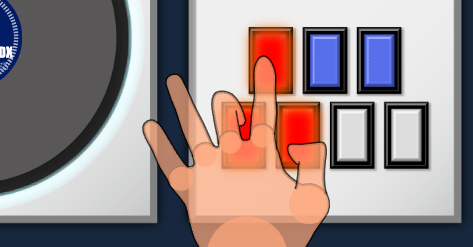
This style keeps the natural ordering of fingers, which can be less confusing than other styles.
The issue with this playstyle is that you need to bend your middle finger a lot, since it’s much longer than your thumb. For this reason, it may be difficult to time on buttons 1 and 2, and you may have difficulties hitting 1-2 trills or denim patterns.
Example: DOLCE, especially around 30 second mark. Compare to more recent video of him playing the same chart where he’s mostly using 1048.
Ring-middle-index (aka the claw)
Many people who started out playing rhythm games on a keyboard naturally transition to this playstyle, since it matches linear layouts used in many games.
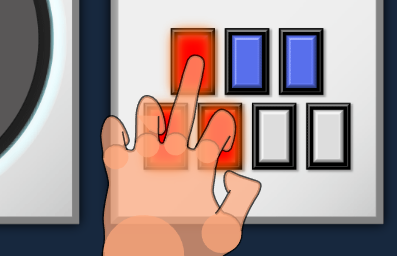
This style was frequently used in the past as well, but it is considered less than ideal – it has a severe downside that you cannot hit the turntable, so you must temporarily switch to a different playstyle when you see scratches.
3/4 split - button hand (4567)
The first two styles - ring on 7 and pinky on 7 - are the two popular choices.
The choice between ring or pinky on 7 depends on your preference; you might find one more comfortable than the other. That being said, using the pinky is considered more “ideal” since movement of the ring finger is less independent (it’s somewhat tied to the muscles of the middle finger).
It’s worth noting that in almost all cases, index hits 4 and thumb hits 5. This “reversed” ordering of fingers is a source of confusion, especially for new players coming from other rhythm games.
Index-thumb-middle-ring (ring on 7)

Index-thumb-middle-pinky (pinky on 7)
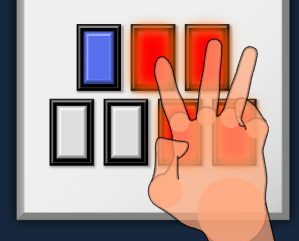
Normally, you would use the tip of your pinky to press the button in this style. There is also a variant of this style is called flat pinky; here, you use the blade of your pinky instead of the tip.
Others
Other combinations are rarely sighted but they do exist (index-thumb-ring-pinky, index-middle-ring-pinky, for example).
2/5 split (S+12 / 34567)
It’s worth noting here that most players use one of the 3/4 split playstyles above as their primary style, and 2/5 as a secondary option for heavy scratch-sections. There are not many players who who use a 2/5 playstyle as their primary one. The videos below are shown only to illustrate the respective styles.
Scratch hand (S+12)

This is your only choice in 2/5 basically.
Button hand (34567)
2/5 transitional

Above image demonstrates various techniques used in this style, assuming that you typically play index-thumb-middle-pinky.
There are no hard rules, but usually:
- Button 3: thumb
- Button 4, index
- Button 5: the problem, use your thumb / index / middle / ring / pinky, whatever the situation demands
- Button 6: ring (or middle, if you know how to middle-6 from DP)
- Button 7: ring or pinky, depends on your 3/4 style
Example - MACAO6 playing Plan 8 with mostly 2:5, with one-hand and 1048 mixed in
1:1
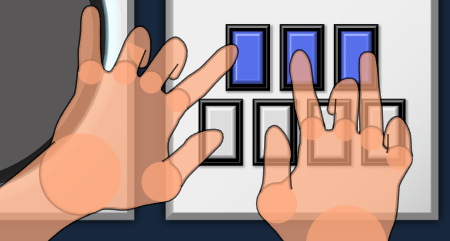
You use all of your fingers to hit buttons 3-7 with a fixed 1:1 mapping.
Not as common as it is not very comfortable.
4/4 split (S+1234 / 4567)
Symmetric
This was one the most popular playstyles long ago – but has since fallen out of favor.
Popularized by former top ranker Silver (FINE* / SILV) who retired at his peak during Happy Sky.
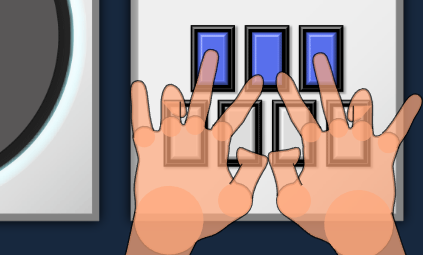
Ring on 1, middle on 2, thumb on 3, and index on 4. Mirrored on the right hand, which means you share button #4 with two fingers. You can use your pinky instead of the ring finger as well.
The (severe) downside to this playstyle is that you cannot possibly hit the turntable with your hand fixed in symmetric position, so you would need to temporarily switch to a different style.
Example - TOTORO playing One More Lovely with mostly symmetric
Example - TOTORO playing Symmetric and transitioning into becha press
Example - FINE*; starts at 9:30
Other uncommon / less “viable” play styles
Freeform (?)
While this isn’t strictly a playstyle, it’s worth highlighting here. “Freeform” refers to more loose style where hands and fingers can hit whatever button, finding the “optimal” placement demanded by a chart. Before the difficulty spiked through the roof in IIDX – it was not uncommon to see high level players use unconventional playstyles. These days, this technique is seen less often (in favor of more fixed / conventional styles described in previous sections) but still used by some players to handle certain patterns – like denims and rapid jacks.
Dolce was well known for this; if you watch his old videos this is evident. Example - V by DOLCE during Happy Sky, and Example - Second Heaven by DOLCE which was taken on SIRIUS. Compare the videos above to more recent example taken during Cannon Ballers where his style is more fixed.
Example - Scripted Connection A mix by KAME
One handing
Two types of one hand players:
- players who choose to play SP one-handed exclusively
- players who use one hand technique for things like scratch-heavy charts
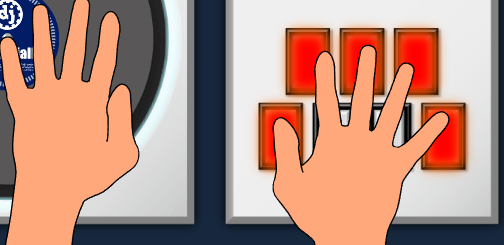
IIDX SP is meant to be played with two hands on the buttons. Playing exclusively one hand is challenging, and the difficulty curve will be extremely inconsistent compared to other play styles.
It’s also not a necessary skill, even as a complimentary style to other two-handed styles. Sure, it could be useful in very specific patterns in specific scratch-heavy songs, but those are very rare. There are a several level 12 charts where one-hand skills could be useful… out of 470+ total level 12 charts.
Therefore, if you are new to the game, it is strongly recommended that you don’t play one hand. For intermediate level players, it’s also not really recommended that you separately practice one hand for reasons explained above.
Example of one-hand only players:
One-handed Copula SP Kaiden by MESO - their newer videos are also worth a watch.
Examples of one-hand technique used in scratch-heavy songs:
Hokuto (北斗)
Hokuto is a style that does not have a static assignment of fingers to buttons, instead moving the hands around to hit buttons as the chart demands. Hokuto players tend to use a limited set of fingers (usually index and middle, sometimes thumb).
